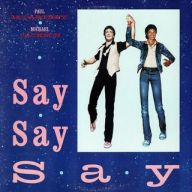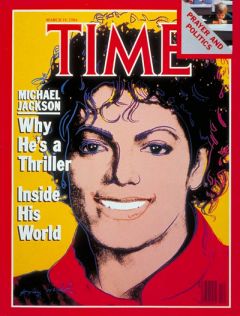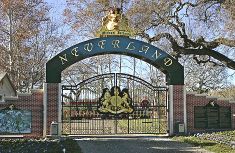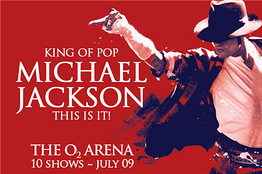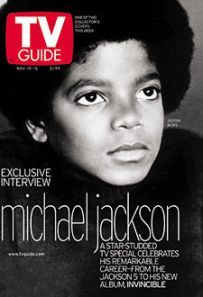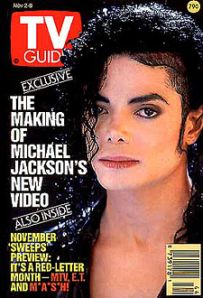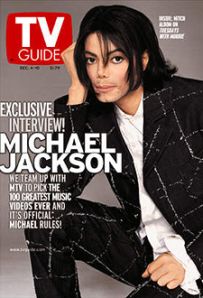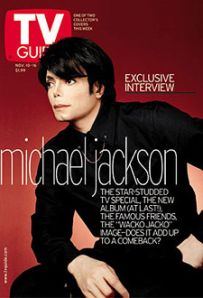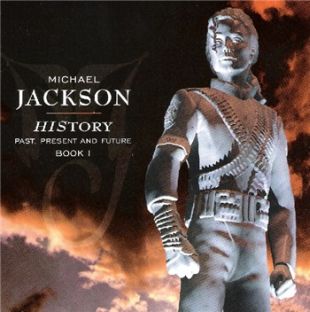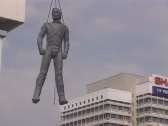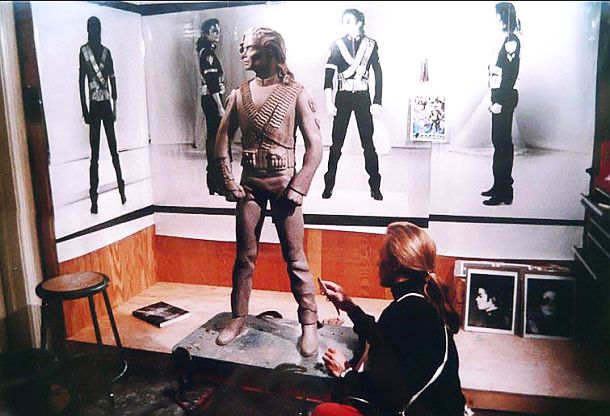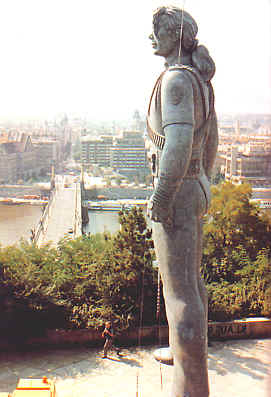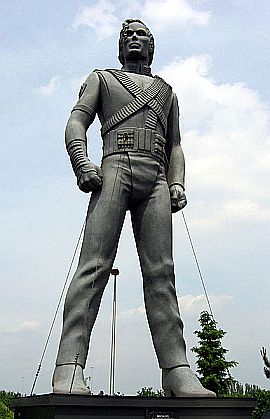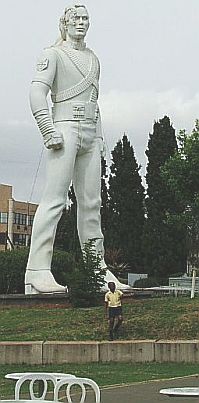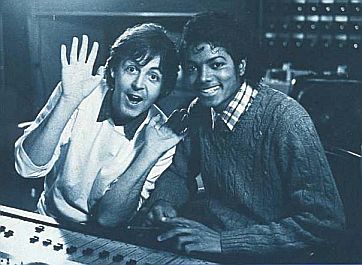
Paul McCartney and Michael Jackson in studio during their early 1980s’ collaboration. Photo, Linda McCartney
After John Lennon was killed in 1980, the three remaining Beatles came together briefly for George Harrison’s song, “All Those Years Ago.” But for the most part, they each continued working solo, with occasional collaborations.
In the early 1980s, Paul McCartney and pop star Michael Jackson came together briefly to produce a few songs and videos. These projects undertaken jointly between 1981 and 1983. McCartney by then already had a decade of success with his group Wings, releasing a number of singles and albums between 1971 and 1981. Michael Jackson at that time was just hitting his stride, having released his first solo album Off the Wall in 1979, and then his blockbuster, Thriller, in 1982. In the McCartney/Jackson collaboration of the early 1980s, the two artists produced a few singles together that were also used on each other’s albums and for music videos. However, this collaboration became a very interesting pairing given what would later transpire between McCartney and Jackson in terms of their respective business interests. More on that in moment. First the music.
“The Girl Is Mine”
The first single released jointly by Paul McCartney and Michael Jackson was “The Girl is Mine,” a 1982 duet by the two artists. The song was written by Jackson and produced by Quincy Jones for Jackson’s epic Thriller album, his sixth studio album. “The Girl is Mine” was recorded in Los Angeles in April 1982. It was released as a single on the Epic label in mid-October of that year with “Can’t Get Outta the Rain” on the B side. It soon topped the R & B singles chart, peaking at No. 2 on the Billboard Hot 100, and rising to No. 8 in the U.K. By 1985, it had sold 1.3 million copies, and was later certified platinum by the Recording Industry Association of America for shipments of at least two million units. Jackson stated at one point that the recording of the song was one of his most enjoyable moments in the studio. “One of my favorite songs to record, of all my recordings as a solo artist, is probably ‘The Girl Is Mine,’ because working with Paul McCartney was pretty exciting and we just literally had fun. It was like lots of kibitzing and playing, and throwing stuff at each other, and making jokes. We actually recorded the track and the vocals pretty much live at the same time, and we do have [film] footage of it…” The footage of the pair recording the song was later shown at The Paul McCartney World Tour.
Visit With Paul
The second song released jointly by McCartney and Jackson was “Say, Say, Say,” which would also appear on McCartney’s fifth solo album, Pipes of Peace, released in 1983. The history of this Jackson/McCartney collaboration actually predates “The Girl is Mine” single of 1982. And it was during this recording visit that Jackson would be introduced to the financial value of the music publishing business. “Say, Say, Say” was recorded at Abbey Road Studios from May to September 1981. During one of Michael’s visits to the McCartney home in 1981, Paul pro- duced a thick booklet of song publishing rights he owned. “This is the way to make big money,” he told Jackson. Michael Jackson had come to the U.K. as a guest of Paul, as the two had agreed to explore joint music projects. While there, Jackson stayed at a nearby hotel, but often had dinner at the home of Paul and Linda McCartney, a Tudor estate on hundreds of acres about an hour’s drive from London. During these visits, Jackson and the McCartneys developed a friendship, sometimes hanging out in the McCartney kitchen for informal conversation. One night at the McCartney dinner table, Paul produced a thick booklet displaying all the song and publishing rights he owned, such as those of 1950s’ rocker Buddy Holly and others. “This is the way to make big money,” he told Jackson. “Every time someone records one of these songs, I get paid. Every time someone plays these songs on the radio, or in live performances, I get paid.” McCartney was then reportedly earning about $40 million a year from other people’s songs. Jackson became quite interested as McCartney paged through his booklet. He wanted to know more about owning songs, and how they were acquired and put to use. This dinner-table vignette of Paul advising Michael on the lucrative world of music publishing and song ownership, would later play out in a somewhat ironic way, as Jackson would come to own a number of Beatles songs.
Meanwhile, the McCartney/Jackson recording of “Say Say Say” was completed in February 1983 with former Beatles’ producer George Martin helping with its studio production. “Say, Say, Say” proceeded to have a good run on the music charts, hitting No.1 on the Billboard Hot 100 and staying there for six weeks in late 1983 and early 1984.A fairly elaborate music video for “Say Say Say” was also produced, at a cost of $500,000, which featured Jackson and McCartney, with appearances by Linda McCartney, LaToya Jackson, and Mr. T. Another McCartney/ Jackson song that appears on McCartney’s Pipes of Peace album is “The Man,” co-written by Paul and Michael, but not released as a single.
Paul and Michael, meanwhile, continued their friendship and musical relationship through the 1980s — that is, until some mutual musical and financial interests came between them.
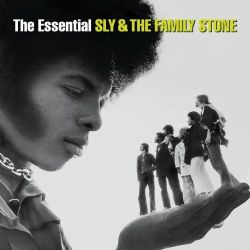
Among the first catalogs Michael Jackson acquired in the mid-1980s was one with the songs of Sly & the Family Stone such as ‘Everyday People.’
In 1983-84, having taken Paul McCartney’s advice to heart about making money with music publishing rights, Michael Jackson was soon on the hunt to buy music catalogs and song copyrights. Within a year or two, he spent about $1 million buying up some available collections — the Sly Stone collection, which included songs such as, “Everyday People”(1968) and “Everybody Is a Star” (1970).
Jackson also acquired Len Barry songs such as “1-2-3” (1965), the Soul Survivors’ “Expressway to Your Heart” (1967), and two 1961 songs by Dion DiMucci — “The Wanderer” and “Runaround Sue.”
Jackson continued his search for more music catalogs to buy, but only those with songs that meant something to him. He was shown dozens more catalogs, approaching 40 or so, but he only bid on a handful of these. Then came the prize he wanted badly: a catalog of Beatles songs. First, a little history.
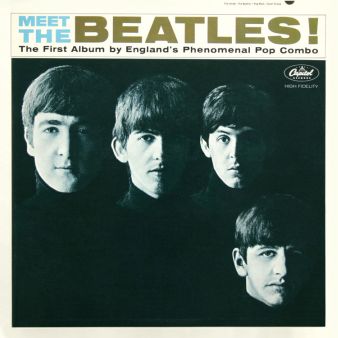
Early Beatles’ songs -- such as those from their early 1960s albums -- became part of the ATV music catalog that Michael Jackson acquired in 1985.
In 1968-69, a U.K. company named ATV Music Publishing, a subsidiary of Britain’s Associated TeleVision, had become the owner of 250 or so Beatles’ songs — many of which were the most important “Lennon & McCartney” compositions from the 1960s. How the Beatles’ songs made their way to these owners is a bit of another story which is covered at length elsewhere. But essentially, for tax reasons, the Beatles put much of their music publishing rights into a public company, which they later lost control of. ATV became the owner. ATV Music Publishing had formed in the late 1950s after it acquired Pye Records, one of the major U.K. record companies at the time. ATV and Pye were at the forefront of the 1960s music explosion in the U.K. Among artists then on the Pye label were The Searchers, The Kinks, Donovan, The Moody Blues, and Petula Clark. Through the 1970s, ATV remained the owner of the Beatles catalog and expanded its holdings to other songs. By 1984, however, the ATV Music Publishing became the property of a new owner — an Australian investor and corporate raider named Robert Holmes a Court. Holmes a Court was interested in turning quick profits on his investments and he soon let it be known that the ATV music catalog — then comprised of some 4,000 songs including those by the Beatles — was up for sale. That’s when Michael Jackson entered the bidding.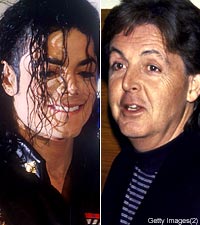
In the mid-1980s, Michael Jackson and Paul McCartney both wanted the Beatles songs in the ATV music catalog.
Paul McCartney, meanwhile, was also keenly aware of the ATV holding. One account claims that McCartney had made it known to the owners that he would be willing to top any best offer by 10 percent. However, McCartney is also on record saying that at one point he was offered the catalog for a price of £20 million (pounds). But McCartney was hesitant to make that deal on his own, since it might be perceived by Beatles fans as a “Paul McCartney grab” of John Lennon’s property, and he didn’t feel comfortable with that. So he called Lennon’s widow, Yoko Ono, and asked her if she wanted to split the bid at £10 million each. That arrangement did not work out for whatever reason, and McCartney appeared to drop out of the process. Michael Jackson, however, really wanted the catalog, and especially the Beatles’ songs, and he set about on a careful and thorough business course to acquire it.
Jackson was first informed of the availability of the ATV catalog in September 1984 by his attorney John Branca, who put together the earlier catalog acquisitions that Jackson had already made. That September, Branca, Jackson, and his manager, Frank Dileo, were in one of their regular business meetings during Jackson’s Victory tour with his brothers in Philadelphia. Jackson was very excited at the news of the ATV/Beatles catalog becoming available, but Branca warned him it would be a tough fight as other investors were also interested, and Holmes a Court was a tough negotiator. Branca also reportedly contacted an attorney for McCartney, who said McCartney was not interested in bidding for the catalog as it was “too pricey”. Branca and his associates then set out on a careful course of “corporate due diligence” checking out their quarry and later spending $1 million over some months to verify the validity of ATV’s claims about earnings and song ownership.
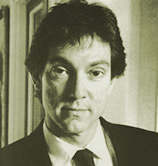
Attorney John Branca became key Jackson aide.
|
“We Are The World” During the time Jackson’s team of lawyers and music specialists were trying to acquire the ATV/Beatles music catalog, Jackson was also involved with his music for a good cause. He teamed up with fellow singer Lionel Ritchie to write a song for Ethiopian charity relief that became “We Are The World.” The song was produced and conducted by Quincy Jones and became notable for the “supergroup” of 45 popular musicians who performed it — from Bob Dylan, Bruce Springsteen, and Diana Ross, to Paul Simon, Stevie Wonder and Ray Charles — and dozens of others. The charity single was intended to raise funds to help famine-relief efforts in Africa, which had unusual drought in 1984/1985. The recording was produced in January 1985 and released in March 1985. It became one of the fastest- selling singles in the modern pop era, reaching No.1 on the Billboard Hot 100 on April 17, 1985 and remaining there for four weeks. The single eventually sold 7.5 million copies in the U.S. and also spawned an album and a video — all of which raised over $63 million for famine relief. The song also inspired millions of people to help, and many lives were saved. The song went on to win four 1985 Grammys. Michael Jackson performed the song at the World Music Awards in November 2006. |
In the end, Jackson would win the prize — but only after a long and protracted chess game with Holmes a Court that went on for some 10 months or more, and who for a time, erroneously suspected that Jackson was a front man for a Paul McCartney purchase. In any case, for Jackson’s camp, the process of putting the deal together, and verifying the assets, businesses, and copyrights, etc. was not a casual process, as Los Angeles Times reporter Robert Hilburn explained in 1985:
…One team of Jackson’s lawyers was sent to the United States Copyright Office in Washington to check on the authenticity of every significant composition in the nearly 4,000-song catalogue. Meanwhile, other teams were at work in London and at ATV offices around the world to certify legal documents in those countries. In total, an estimated half a million to a million pages of contracts were examined.
At the same time, the L.A.-based accounting firm of Gelfand, Rennert & Feldman was overseeing a team of 20 people who were checking ATV books in London, Los Angeles, Toronto, Sydney, Munich and Amsterdam.
The contract for the prospective deal had gone through eight drafts. But then, negotiations broke off for a time and the deal seemed doomed. In June 1985, Branca and Jackson learned that Holmes a Court had signed a tentative $50-million deal with Charles Koppelman and Marty Bandier’s Entertainment Co. Talks then resumed between the Jackson and Holmes a Court negotiating teams. Jackson raised his bid to $47.5 million. Holmes a Court accepted Jackson’s bid over the higher $50 million from Koppleman/Bandier presumably because Jackson’s was more liquid and could be consummated quicker. Jackson also reportedly threw in a charity concert in Perth, Australia. An announcement was made in mid-August 1985 that Michael Jackson had acquired the ATV music publishing catalog with the Beatles songs. Michael Jackson was a happy camper.
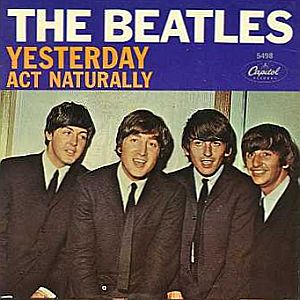
Michael Jackson said ‘Yesterday’ was his favorite Beatles song. Released as a single in the U.S. in Sept 1965, it stayed at No.1 for the month of October and sold 1 million copies in five weeks.
Meanwhile, Paul McCartney, who had wanted the ATV Beatles’ songs, apparently was unable or unwilling to raise enough money or pay for the entire 4,000 song ATV catalog. As noted earlier, McCartney at one point urged Yoko Ono to join him in a joint bid, but she declined. Ono did comment upon hearing that the rights were acquired by Jackson. “Michael Jackson is a fellow songwriter,” she said, “so I just think it’s a nice thing to happen.” McCartney, however, did admit to feeling somewhat undercut by his one-time friend and collaborator. “I think it’s dodgy to do things like that,” McCartney reportedly said, “– to be someone’s friend and then buy the rug they’re standing on.”
The publisher’s rights that Jackson acquired were distinct from those of the songwriter. McCartney still had those, of course, as royalties for “Lennon & McCartney” songwriting still flowed to McCartney and to John Lennon’s estate regardless of who held the publisher’s rights. Still, publisher rights could be quite lucrative — as Paul had shown Michael back in 1981. The Beatles songs, in particular, would be especially valuable resources that could be mined for years with possible uses in film, television, advertising, stage productions, video games, and more. The prize that Jackson had won would become a very valuable asset indeed. In fact, it would prove to be one of the best investments Michael Jackson would ever make.
Nike Ad
The first unpleasantness between McCartney and Jackson over the use of Beatles music came in 1987 when Nike struck a deal to use the Beatle’s song “Revolution” in one of its athletic shoe television commercials. At the time, Nike reportedly paid $500,000 to use the song, half to EMI-Capitol Records and half to Jackson. The three surviving Beatles, along with their record label, Apple, filed a lawsuit objecting to Nike’s use of the song. The suit was aimed at Nike, its ad agency, and Capitol-EMI Records — not Jackson. The Nike TV ad with the Beatles music — and there were at least three versions — ran from 1987 through early 1988, even as the litigation proceeded, with former Beatles George Harrison and Paul McCartney objecting in the press.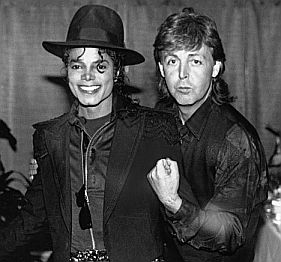
Michael Jackson & Paul McCartney together in 1990, reportedly to dispel rumors about their falling out over the Beatles song catalog Jackson then held.
Then in early November 1995 George Harrison and Paul McCartney made comments in the U.K.’s Elle magazine about Jackson’s use of Beatles songs in advertising. Harrison made remarks similar to those he had made during the 1988 fight over Nike’s use of “Revolution” in their TV ad. “Unless we do something about it,” said Harrison, referring to the merchandising of their songs, “every Beatles song is going to end up advertising bras and pork pies.” McCartney added that Jackson had “cheapened” the songs released.
Financial Problems
Jackson by then was beginning his descent into serious financial difficulty as he began to leverage his assets for cash and credit. On November 9, 1995 it was reported that Jackson had sold a 50 percent stake in the ATV/Beatles song catalog for about $100 million — money used by Jackson, according to one adviser, to help shore up his “wobbling accounts.”
Although Jackson was a smart guy when he wanted to be, and was on top of his financial situation for a good part of his career — and actively involved with his business interests — by the mid-1990s things started to slip pretty badly. Jackson’s exorbitant and quirky life style — coupled with legal battles and lower music revenues — would soon eat away at his assets and push him into big-time indebtedness.
In the 1980s, Jackson had made a ton of money, with top-selling albums and concert tours. But he spent it as fast at it came in, and then some, often in bizarre ways, chartering jets and renting hotel suites for his entourages, or traveling with a pet chimpanzee.
In his work, as well, Jackson spared no expense, hiring the best at premium rates. In 1987, for example, he hired noted film director Martin Scorsese for $1 million to direct a video for his album Bad.
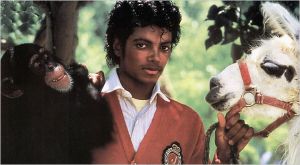
Michael Jackson’s quirky and expensive life style in the 1980s and 1990s, helped push him into big-time debt.
In California, Jackson’s Santa Barbara County estate, “Neverland” — purchased in 1987 for $19.5 million — was a continuing and considerable expense. Neverland, named for the island of Peter Pan and the Lost Boys who never age, soon encompassed some 2,600 acres. Jackson spent $35 million making it a wonderland complete with amusement park, small-car race track, miniature railroad, a pet zoo, ornate landscaping and flower beds, a 50-seat cinema, and two helicopter landing pads. At its peak, Neverland had a staff of 150, and cost $10 million a year to maintain.
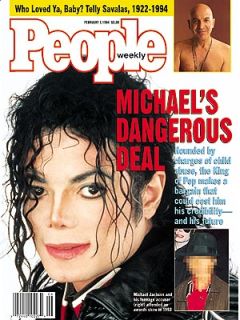
People magazine cover story on Michael Jackson in Feb 1994 asked if his settlement with a young accuser might cost the pop star his credibility – and his future.
By the late 1990s he had taken out hundreds of millions of dollars worth of loans. He used some of the loan money to invest in risky ventures. “The leading drain on Mr. Jackson’s ample resources may have been monumentally unwise investments that apparently produced equally colossal losses,” wrote New York Times reporters Jeff Leeds and Andrew Ross Sorkin in a later story on the evolution of Jackson’s financial troubles. Among the unwise investments was $50 million or so for deals that never panned out — amusement-park ideas and global-scale entertainments featuring giant Marvel comic-book type characters. Jackson was getting bad advice. By early 2000, Jackson’s biggest burden began shifting to his enormous monthly interest payments on his debt. At one point in 2000, Jackson’s finances were so shaky that one of his financial advisers warned that Jackson’s control of the rights to his own music catalog and that of the Beatles was at risk.
Sell The Beatles?
In early 2001, there had been rumors that Jackson was putting the ATV/Beatles catalog up for sale to cover the maintenance of his Neverland ranch in California as well as legal bills relating to cancelled concert tours. Jackson then made a statement to the press in May 2001 about the status of the Sony/ATV/Beatles catalog. “I want to clarify a silly rumor,” he said in a May 9, 2001 statement, “the Beatles catalogue is not for sale, has not been for sale and will never be for sale.” Still, the catalog was becoming less and less his to control as he diminished his share to hold off his creditors.
|
Comeback In 2001? In the fall of 2001, it appeared there might be a re-emergence of Michael Jackson. In September he made a surprise appearance at the 2001 MTV Video Music Awards, as he joined ‘N Sync on stage near the end of their act and performed some of his dance moves. At the end of October 2001, Jackson’s new album, Invincible was released, rising to the top of the charts. In November 2001, Michael Jackson appeared on the cover of TV Guide. The Guide touted his upcoming TV special on its cover — “Michael Jackson: The Star Studded TV Special, The New Album (at last), The Famous Friends, The “Wacko Jacko” Image — Does it Add Up to Comeback?” In 2002, however, Jackson had some legal troubles. His longtime concert promoter Marcel Avram, sued Jackson for $21.2 million for canceling two Millennium concerts. A court ordered Jackson to pay Avram $5.3 million in damages. |
Meanwhile, there appeared to be little change in Jackson’s spending habits. In September 2001, he paid a $1 million fee to Marlon Brando to appear at a Madison Square Garden event and in a video honoring Jackson. In the spring of 2002, he racked up a $100,000 hotel bill on a brief trip to New York. And he could still drop $1 million at a time on any number of shopping expeditions, for antiques, automobiles, paintings, or other luxuries. Forbes scored him as owing a Beverly Hills jeweler $2 million for a watch, and once on a whim he spent $10,000 on a bottle of perfume for his friend Elizabeth Taylor.
By November 2003, it didn’t appear that Jackson was in imminent danger of going broke, as Forbes magazine placed his net worth at $350 million. But he then had heavy liens against his property and his spending was characterized as “out of control”.
Forbes also noted of Jackson: “for the first time in four decades, he finds himself without a record contract.” The magazine described him as “a franchise in decline.” Number Ones, a Jackson greatest-hits album, released in 2003, would sell about 1 million copies, considerably less that other Jackson albums.
By 2005, a turn for the worse occurred, especially with Jackson’s very public trial on charges of molesting a young boy. Although acquitted, more of Jackson’s financial turmoil surfaced in the trial. An accountant testified that Jackson spent up to $30 million per year more than he earned. His loans were soon becoming his major liability, with crushing interest payments.
By 2005, Jackson was reportedly making monthly payments of about $4.5 million on $270 million in debt, which works out to an annual interest rate of about 20 percent, a rate that usually signals high risk.
Jackson’s partner in the ATV/Beatles catalog, Sony, was now concerned about the prospect of a Jackson bankruptcy. They also wondered who they might have to negotiate with as their partner, especially since Jackson by then had established that his share would be represented by a trust. For Sony, that added to the uncertainty, and they remained attentive to Jackson’s situation.
Sony Steps In

Logo for Sony/ATV Music Publishing.
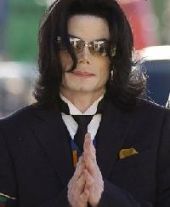
Michael Jackson in more recent years.
Through all of Jackson’s difficulties and financial woes, however, his music publishing interests were a key asset, anchored by the 251 Beatles songs. He was personally involved with that business, and the idea of doing more with it in the future appealed to him. In addition to his share of the Sony/ATV/Beatles catalog, he also held his own publishing catalog, called Mijac. That catalog is estimated to be worth $50 million to $100 million, but it too has an unknown amount of debt attached.
Catalog Grows
The Sony/ATV/Beatles catalog, meanwhile, had grown significantly in size and value since Jackson first acquired it in 1985, especially in recent years. Between November 2001 and May 2007, Sony/ATV had made at least four acquisitions of other music catalogs. There were now more than 500,000 songs in the Sony/ATV catalog — including tunes by Elvis Presley, the Drifters, Little Richard, Hank Williams, Roy Orbison, Taylor Swift, and the Jonas Brothers. At Jackson’s death, the Sony/ATV/ Beatles catalog was said to be worth $1 billion and held more than 500,000 songs. Among songs now found in this catalog, for example, are “Blowin’ in the Wind” by Bob Dylan, “Sweet Caroline” by Neil Diamond, “E-Pro” by Beck, “Crazy” by Willie Nelson, and “No Such Thing” by John Mayer. The works of a number of songwriters are also included, among them: Stevie Nicks, Sarah McLachlan, Destiny’s Child, Garth Brooks, and Richie Sambora of Bon Jovi. Still, in terms of earning power, the 251 Beatles songs are the most significant group, whether in terms of generating regular or “mechanical” royalties from CD sales, or future use in advertising and other commercial ventures. Bachman Turner Overdrive’s “Takin’ Care of Business,” is one example of a Sony/ATV song licenced for a major advertising campaign, in this case, for Office Depot.
At Jackson’s death in June 2009, the Sony/ATV/Beatles catalog was said to be worth $1 billion. How much of that would accrue to the Jackson estate, however, was unclear given his indebtedness and other possible liabilities.
Paul McCartney

Paul McCartney, at premiere of the show 'Love' by Cirque du Soleil, Las Vegas, June 2006.
After Jackson’s passing in June 2009, McCartney publicly offered his respects and condolences, commenting on his time working with Jackson. “I feel privileged to have hung out and worked with Michael,” McCartney said, calling him “massively talented” and a person with a gentle soul. “His music will be remembered forever and my memories of our time together will be happy ones,” he said. With Jackson’s passing, there had come rumors that Jackson had planned to give the rights back to the Beatles. In fact, it was rumored that Jackson had intended to do so in his will, in order to make amends with Paul McCartney. But when the will surfaced, there was no mention of such a transfer. And Sony stepped in to say that the Beatles portion of the Sony/ATV catalog was going nowhere and would remain in their custody. McCartney, for his part, seemed to be mellowing somewhat on the whole matter, explaining that with time, certain rights would revert to him anyway.
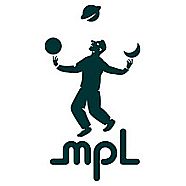
Logo for McCartney Productions, Ltd., Paul McCartney’s music business.
MPL stands for “McCartney Productions Limited,” the company that operates out of London and New York. MPL has grown over the years and is now comprised of 25 subsidiary companies, some with names such as Desilu Music Corp, ARKO Music Corp., and others. MPL owns a wide range of copyrighted material stretching over 100 years, including songs such as, “Rock-a-Bye Your Baby With a Dixie Melody” made famous by Al Jolson, to show tunes, pop music, and rock ‘n roll songs such as 1960s classics from the Four Seasons, “Sherry” & “Big Girls Don’t Cry.” There are also standards in the MPL collection such as “Autumn Leaves,” “Sentimental Journey,” and “Stormy Weather.” MPL also represents musicals and their songs such as: “How To Succeed In Business Without Really Trying” by Frank Loesser, and “A Chorus Line” by composer/arranger Marvin Hamlisch and lyricist Edward Kleban.
The Jackson Legacy
Michael Jackson’s own music catalog, meanwhile — including previously unreleased material — is likely to become one of the all-time most valuable music catalogs in modern music history. Given the popular reaction to his music since his death, with his past albums dominating the charts in June and July 2009 — plus the prospect of all kinds of uses for his music in the years ahead — it is expected that a music business legacy equivalent to, or exceeding that, of Elvis Presley, Rodgers & Hammerstein, Frank Sinatra, the Beatles, and other famous music names will be quite possible. Only time will tell, of course, with history as the final judge.
For another Michael Jackson story at this website see, “The Jackson Statues, 1995,” a story of nine giant Michael Jackson statues used to promote Jackson’s 1995 HIStory album and world tour. For additional Beatles and Paul McCartney stories at this website see, “Beatles History,” a topics page with links to 12 Beatles stories. Thanks for visiting – and if you like what you find here, please make a donation to help support the research and writing at this website. Thank you. – Jack Doyle
Addendum/Update: In 2012, Sony/ATV Music Publishing and other investors acquired EMI Music Publishing for approximately $2.2 billion. In doing so, Sony/ATV, as principal administrator, became the world’s largest music publisher with a library of over 2 million songs. As of March 15th, 2016, Sony acquired the Michael Jackson share of the Sony/ATV Music Publishing catalog for $750 million, which included classic Beatles material. Meanwhile, Paul McCartney has begun a legal process to regain his portion of that Beatles catalog using a provision of the U.S. Copyright Act of 1976 which allows original songwriters to regain their U.S. publishing rights after a certain time period, which for McCartney would begin in 2018.
|
Please Support Thank You |
_______________________________
Date Posted: 7 July 2009
Last Update: 27 February 2019
Comments to: jdoyle@pophistorydig.com
Article Citation:
Jack Doyle, “Michael & McCartney, 1990s-2009,”
PopHistoryDig.com, July 7, 2009.
_______________________________
Sources, Links & Additional Information
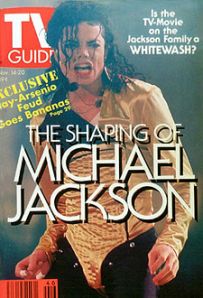 TV Guide, November 14, 1992. |
“Beatles’ Song Rights Reported Sold,” New York Times, August 16, 1985.
Wm. Knoedelseder Jr., “Michael Jackson Pays $40 Million for ATV Music; Beatles Song Catalogue Acquired,” Los Angeles Times, August 15, 1985, Business, p. 1.
Robert Hilburn, “The Long and Winding Road,” Los Angeles Times, September 22, 1985.
J. Randy Taraborrelli, Michael Jackson: The Magic and The Madness, Birch Lane Press, 1991.
Michael Jackson (autobiography), Moon Walk, New York: Doubleday, 1988.
“Say, Say, Say,” Wikipedia.org.
Jay Cocks, Elizabeth L. Bland, New York, and Elaine Dutka, Los Angeles, “Wanna Buy a Revolution?,” Time, Monday, May 18, 1987.
Andrea Adelson, The Media Business, “EMI to Pay Michael Jackson $70 Million to Manage Music,” New York Times, November 25, 1993.
Angella Johnson, “Jackson Angers Ex-Beatles,” The Guardian (U.K..), Monday November 6, 1995
John Horn, “Jackson Sells Beatles Songs to Sony,” Associated Press, November 9, 1995.
“Jackson ‘Will Not Sell’ Beatles Songs,” BBCNews (U.K.), Thursday, May 10, 2001.
Shaheem Reid, “King Of Dirty Pop? Michael Jackson Joins ‘NSYNC At VMAs,” MTV.com, September 6, 2001.
Brett Pulley, “Michael Jackson’s Ups And Downs,” Forbes, November 21, 2003.
Richard Harrington, “The King Of Pop’s Fizzled Finances; Soft Sales, Alleged Debt Add to Jackson’s Woes,” Washington Post, November 23, 2003, p. D-1.
“Jackson ‘Financial Crisis’ Denied,” BBC News (U.K.), Friday, February 13, 2004.
Gary Strauss, “Jackson’s Finances Are Solid, Adviser Says,” USA Today, April 27, 2004.
Paul Farhi, “Prosecution Witness Testifies Jackson Was Millions in Debt,” Washington Post, Wednesday, May 4, 2005, p. C-1.
“Jackson’s Beatles Catalog at Risk,” CNN.com, Thursday, June 9, 2005.
“Sony/ATV Music Publishing,” Wikipedia.org.
Stacy Perman, “Michael Jackson’s Financial Thriller,” Business Week, June 15, 2005.
Jeff Leeds and Andrew Ross Sorkin, “Michael Jackson Bailout Said to Be Close,” New York Times, April 13, 2006.
Jeff Leeds and Andrew Ross Sorkin, “Jackson Makes Deal to Overhaul His Finances,” New York Times, April 14, 2006.
“Jackson Strikes Deal Over Loans,” BBC News, April 14, 2006.
Jeff Leeds, The Basics, “Why a Song Catalog Doesn’t Go for a Song,” New York Times, April 16, 2006.
“Michael Jackson,” Wikipedia.org.
Timothy L. O’Brien, Jeff Leeds, Andrew Ross Sorkin, “What Happened to the Fortune Michael Jackson Made?,” New York Times, May 14, 2006.
Jeff Leeds, “Viacom to Sell Music Publishing Unit to Sony/ATV,” New York Times, May 31, 2007.
Ethan Smith, “Economic Reality Prompts a Makeover at ‘Neverland’, Investors Refurbish Michael Jackson’s Estate; No More Orangutans,” Wall Street Journal, June 13, 2009, p. 1.
Ethan Smith, Hollywood Report, “Michael Jackson: The Next Elvis? A Private Equity Group Hopes to Relaunch The Singer’s Career in Vegas,” Wall Street Journal, June 13, 2008 p. W-1.
Alison Boshoff, “Michael Jackson – The Man Who Blew a Billion. The Mind-Boggling Spending of the World’s Wackiest Pop Star,” MailOnline (Daily Mail, U.K.), November 24, 2008.
Deal Book, “The Pop Star and the Private Equity Firms,” New York Times, June 26, 2009.
“We Are The World,” Wikipedia.org.
Liz Thomas, “Question Mark Over Jackson’s Stake in £500m Company That Owns the Beatles’ Songs,” The Daily Mail (U.K.), June 26, 2009.
Tim Arango and Ben Sisario Estate Has Piles of Assets but Loads of Debt, New York Times, June 27, 2009.
Bloomberg News, “Sony/ATV Plans to Keep Rights to Invaluable Beatles Catalogue,” Washington Post, Sunday, June 28, 2009.
Peter McCabe and Robert D. Schonfeld, Apple to the Core, New York: Simon and Schuster, 1972.
A former YouTube video (since taken down), “Michael Jackson …How He Came to Own The Beatles Songs,” included a Paul McCartney press conference in 1990 in which he discussed how Michael Jackson came to own the lion’s share of The Beatles’ Lennon & McCartney song catalog. That press conference was held during a Paul McCartney tour, April 14, 1990, at Joe Robbie Stadium in Miramar, Florida. See related audio clip and transcript of McCartney’s remarks at: MJJinfo.Blogspot.
Brian Southall, Northern Songs: The True Story of the Beatles Song Publishing Empire, Omnibus Press, 2008.

